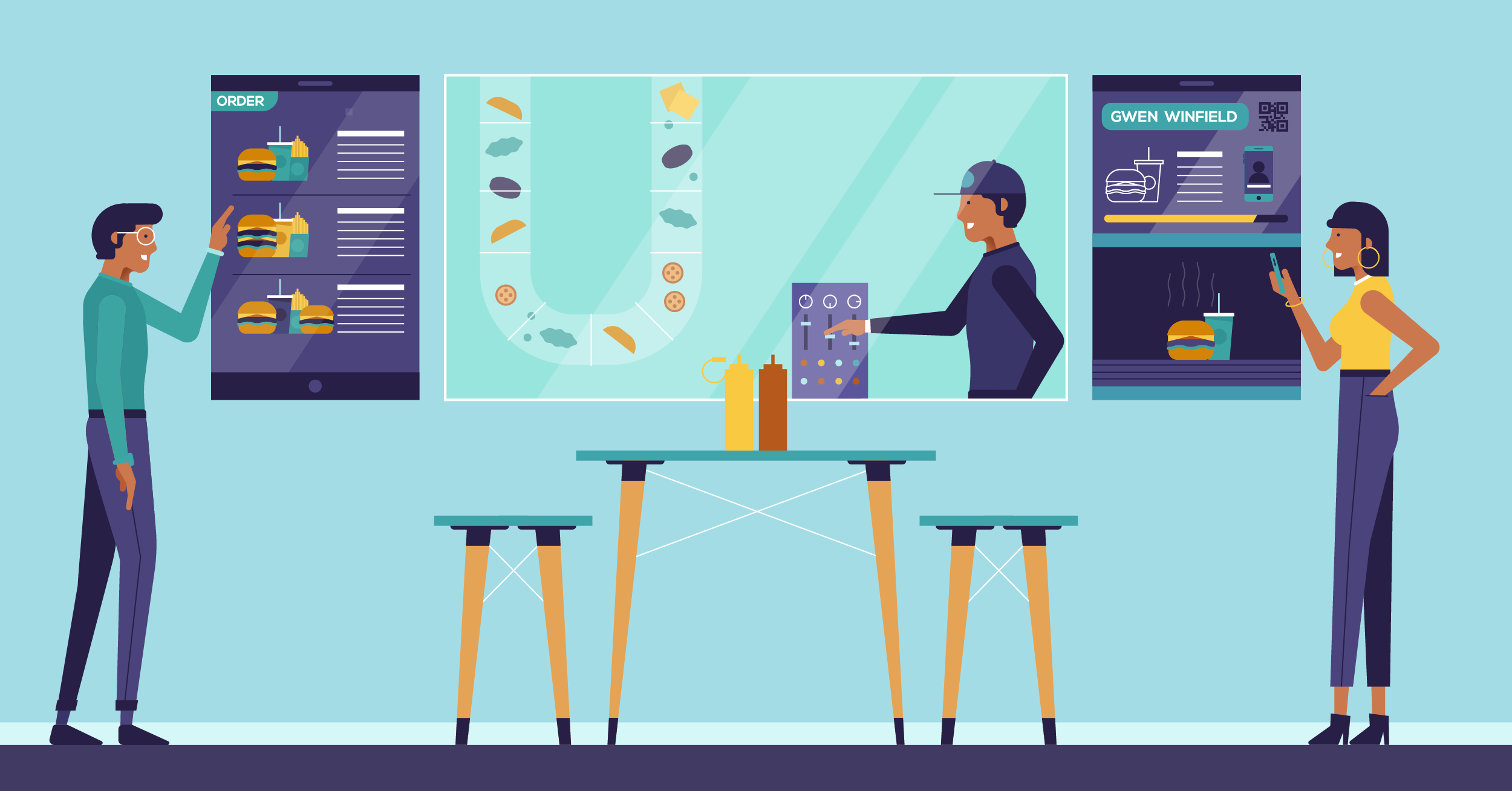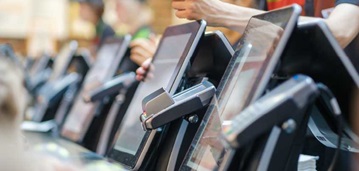The Restaurant of the Future Lets You Have It Your Way

It’s a quarter to noon and your stomach starts to rumble. Just then you sense a vibration. It’s your smartphone. Noting that you often order a veggie burrito sans sour cream, a text message from one of your favorite local restaurants asks if you’d like to get one started this morning. Then it asks if you’d like it delivered or if you’d prefer to come in.
Deciding you’d like to try something different, you decline. The next stop is a local burger joint you like. As you enter, a self-service kiosk recognizes your face. Just then an order goes through for a robot device to start preparing your meal. To pay for your burger, you smile. The restaurant charges the item to your credit card. As you wait, you get a real-time update on the stages of your meal’s progress.
Though this may seem like the restaurant of 2023, all of these technologies are available today. Many are still far from mainstream, but mobile ordering and self-service kiosks quickly are becoming the norm at restaurants. Like other businesses, such technologies aim to make the transition from the digital to the physical world seamless.
Most restaurants continue to resist the pull. Margins are low -- typically 4-8 percent -- and eating is an offline activity. “Restaurants are really takers when it comes to tech,” said Laura Knapp Chadwick, director, commerce & entrepreneurship at the National Restaurant Association. “We benefit from our sister industries, the retailers and the grocers leading the way here.”
While the industry takes its time embracing technology, consumers are increasingly expecting restaurants to use tech to remove friction points like waiting in line, getting the server’s attention and waiting for the check. “There’s a lot of wasted time,” Knapp Chadwick said.
Gut Check
Restaurants have always been at the whim of consumer appetites. Lately, though those cravings have trended toward instant gratification. Spoiled by online retailing, consumers -- especially younger ones -- expect fast delivery and view waiting in lines as a personal affront.
“I think overall what we're seeing is that [consumer] demands are just becoming higher and higher because they're seeing that their needs can be met more quickly,” said Kelly Weikel, director, consumer insights at restaurant industry analyst Technomic. In this environment, free fast delivery is table stakes. “Consumers today don't see anything strange about ordering a coffee for delivery when even five years ago that would seem a little bit absurd,” she said.
This need for convenience dovetails with industrial automation. Self-serve kiosks, which are now becoming common in fast-food restaurants, not only serve customers faster but obviate the need for expensive human workers. In the kitchen, meanwhile, robots are starting to take over routine tasks like burger flipping.
On the back end, Internet connectivity is integral to providing a consistent experience. For instance, Dine Brands, franchisor of Applebee’s Neighborhood Grill + Bar and IHOP, recently inked a deal with Comcast Business Enterprise Solutions to provide a range of managed services. The deal will ensure that all 2,850 Applebee’s and IHOP locations can move data efficiently to and from each restaurant site. The need for such data sharing may not seem obvious, but the chain is using such information to anticipate future needs, deliver loyalty-enhancing interactions and to provide agile and scalable solutions.
Robot Waiters and Staff
In March 2017, a California-based hamburger chain introduced a burger-flipping robot. The bot not only cooked burgers but perfectly assessed their temperature and cooking time. Such back-room bots may be a novelty now or a harbinger of the restaurant of the future.
A restaurant in Nagasaki, Japan, goes further. Humanoid robots there prepare items like okonomiyaki, the Japanese pancake, while his robot colleagues fry donuts. A cafe in Palo Alto, California, features a salad-making robot.
At this writing, some 15 food establishments are using robotic kitchen devices from Chowbotics, a Redwood City, California. Chowbotics’ Founder and CEO, Dr. Deepak Sekar, said he believes that robot staff will soon become common. “Eventually most restaurants will have some element of automation,” he said. “An industrial robot costs five times less today than it did five years ago. Robots are now economically viable for restaurant applications.”
Such robots perform chores like chopping and dicing. Robotic dishwashers (who always show up on time, he notes) can help alleviate labor shortages. Automated vehicles and drones can deliver food in the not-so-distant future.
Sekar isn’t the only one who believes this. McKinsey Global Institute Partner and Principal Michael Chui’s latest research estimates that 54 percent of the tasks workers perform in American restaurants and hotels could be automated by adapting currently available technologies. That makes restaurants the fourth-most-automatable sector in the U.S.
Williams said that there will be robots on the restaurant floor as well, but they will resemble small autonomous vehicles rather than human workers. “It’s not going to be Rosie the Robot from the Jetsons,” he said.
Digitizing Dining
Automats date back to the 19th century, but Eatsa has updated the concept for the digital age. The company’s restaurants let consumers order on their phones or on an on-premises tablet without ever interacting with a human being. Customers then pick up their dishes when they’re ready. While CEO Tim Young said that he doesn’t think every restaurant will look like Eatsa, many elements of the experience – like remote ordering and the chain’s cubby system for picking up their food – will become mainstream for fast-food and fast casual restaurants. Young points out that telling someone else your order only to have them type it into a point-of-sale software solution is archaic in 2018. “There is a much greater trend towards consumers interacting with businesses on their own time and on their own devices,” he said. “It’s more and more what they’re becoming used to.”
They’re also getting used to restaurants that recognize them and, increasingly, anticipate their needs. Consider that instead of a human maître d' or greeter, consumers may get used to talking to a voice-recognition enabled machine. By recognizing data on a customer’s phone or wearable device, they will also be able to greet them by name and suggest their favorite seats or menu items. “They’ll know who you are when you walk in the door and they’ll know your preferences,” said Jeremy Julian, an industry analyst who runs The Restaurant Technology Guys podcast with partner Ryan Williams.
There are other benefits to digitizing consumer interactions. Restaurants have a better idea about wait times. They are even feeding that data to third-party delivery companies so consumers can decide to pull an order if it will take too long. Consumers, meanwhile, increasingly have the choice of delivery or in-store pickup of app-based delivery. Dealing with human workers is becoming less a part of the equation.
When there is a wait time, one tool some restaurants are using to keep customers entertained are Internet-connected touchscreen tables and video screen floors. Rather than give the kids a pail filled with crayons and paper, restaurants can use table-based screens to pacify them. Such screens can also be used to offer some transparency. “In some cases, I’ve even seen them being used to have a chef-cam,” Weikel said. The screens can also be used to showcase different menu options based on the time of day.
Have It Your Way
Of course, the idea of condensing the time from the thought of a burger to experiencing that burger isn’t always appealing. “It’s not a question of the consumer, it’s a question of the occasion,” said Weikel. “Think about Millennials. Sometimes they have a lot going on and they want that seamless experience, but other times they want that socialization. They want to connect over a meal and they want that hospitality.”
Rather than just make fast food faster, digitization will offer consumers more choices. Some restaurants are even providing small boxes where consumers can store their phones during meals for more of an unplugged experience.
“There are two types of dining experiences -- nourishment dining experiences and experience dining experiences,” said Julian. “I don’t think robots are going to play a role in ‘I’m going out to celebrate my birthday’ experiences.”
From mobile ordering and delivery services to employee-assisting robots, restaurants are adapting to the digital world in order to improve their processes and overall customer experience
Locked Content
Click on the button below to get access
Unlock NowOr sign in to access all content on Comcast Business Community
Tags
Learn how Comcast Business can help
keep you ready for what's next.










